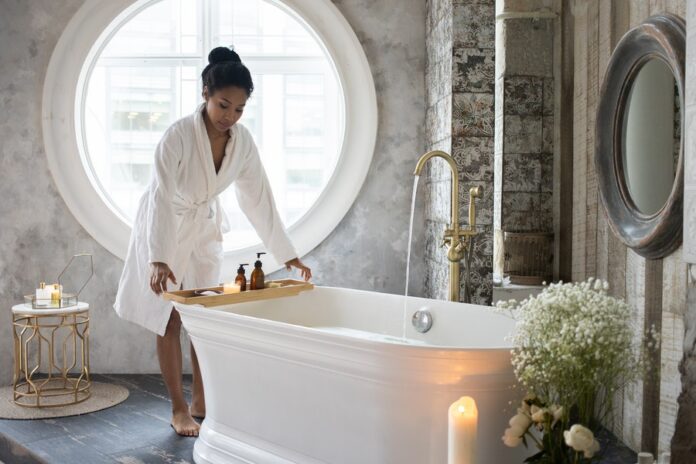Are you looking for a new tub that will look great in your bathroom? There are several reasons why you should think about obtaining a corner bathtub. For one thing, it takes up less space than a freestanding tub, making it an excellent choice if your bathroom is tiny but you still want to enjoy the pleasure of soaking in a bath. It’s also a great option for a crooked bathroom layout because it can just fall back into the corner.
However, this sort of tub works well in larger bathrooms as well, especially if you want to create an airy and open atmosphere. And, despite its tiny and space-saving design, this sort of bathtub is rather big on the interior, so you won’t be soaking in discomfort. Oh, and we’ve previously seen the romantic impact of corner bathtubs in a variety of film scenarios. So, if you’re going to invest in a bathtub, a multifunctional and attractive corner bathtub is a no-brainer.
What Exactly Is A Corner Bathtub?
A corner bathtub is one that has two sides that are supported by walls. They are normally triangular in shape, but maybe built in a variety of shapes and sizes to fit into a corner and are often large enough to accommodate one to two other bathers. The benefit of these bathtubs is that they allow you to install a bathtub in a location that would not normally accommodate a standard rectangular bathtub, giving you more accessible space in your bathroom. Many jacuzzis or hot tubs are called corner bathtubs, and as such, you may enjoy the benefits of them in your house with little alterations, as long as you are prepared to pay for it.
Who Are Corner Bathtubs Intended For?
A corner bathtub is ideal for individuals who have limited floor space in their bathroom like a portable bathroom. A corner bathtub is significantly rounder in shape, allowing it to fit more comfortably in a smaller area, while the standard rectangular bathtub is a bit lengthy in horizontal length. Because the shape of a corner bathtub is large enough to accommodate numerous people, it is great for those who have difficulty bathing alone, such as the elderly and small children.
Corner bathtubs are not just for individuals with the limited room; as previously noted, many of these bathtubs can be turned into hot tubs or jacuzzis, providing you with a much more soothing and exquisite appeal. If you want to add a corner bathtub to your master bathroom, for example, this is a great option.
What Shape Is Best for Your Bathroom?
Corner bathtubs come in a variety of forms, including rectangular, square, triangular, and curved tubs. The optimal form is often determined by the shape of the bathroom. Rectangular bathtubs appear out of place in square bathrooms. The tub will take up one-half of the bathroom, making you feel cramped. A triangular form works best in this scenario. Long and narrow bathrooms, on the other hand, benefit from square and rectangular versions that help balance out the room’s design.
What Is the Best Material for a Corner Bathtub?
Corner tubs, like ordinary tubs, can be made of acrylic, marble, or metal. Corner bathtubs, on the other hand, should complement their surroundings, as opposed to freestanding tubs, which might look excellent in materials that contrast with the rest of the bathroom (especially if your bathroom is tiny). When the bathtub matches the tiles, walls, or sink, it gives the impression that the area is larger than it is. So, if your bathroom decor has marble tiles, choosing a marble bathtub in the same tone may produce a lovely effect in which the two elements melt into each other. Corner tubs are frequently paired with a tub surround. If you choose this form of installation, choose a surround made of a material that complements the bathroom.
How to Install in a Corner Tub
Installing your tub in a corner near the sink is advised for easier access to water and drainage lines. Consider contacting a China Valve supplier for a high-quality hydraulic valve to regulate the flow of water and avoid cases of flooding. The drop-in form is by far the most prevalent sort of corner tub layout. Drop-in tubs are bordered on two or more sides by tile or another wall material. Alcove layouts are very common for corner bathtubs, particularly if one of the walls is tiny enough for the tub to fill it. An alcove corner tub is covered on all sides but one, allowing the tub to fit seamlessly into the area.
How To Make A Corner Tub Enclosure
Enclosing the tub might be useful if you wish to add a shower to it. A corner tub, as opposed to a freestanding tub, is simple to surround with a glass screen. A glass shower enclosure may help keep the chilly air out, providing a warm and steamy spa-like environment. Furthermore, the screen will keep water from getting onto the floor or other bathroom elements, reducing the danger of mildew.
Conclusion
Corner bathtubs are ideal for people who want to brighten up their master bedroom or create a distinct place in their bathroom. They are not for everyone, and in many circumstances, a standard rectangular bathtub will be enough for the majority of individuals. So, as always, do your homework to determine whether a corner bathtub is best for you.






















